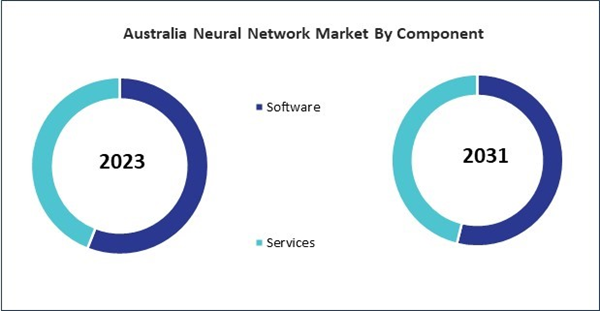The China market dominated the Asia Pacific Neural Network Market by country in 2023, and is expected to continue to be a dominant market till 2031; thereby, achieving a market value of $13.12 billion by 2031. The Japan market is expected to witness a CAGR of 26.1% during 2024-2031. Additionally, the India market would register a CAGR of 27.7% during 2024-2031.
Advancements in deep learning techniques have revolutionized artificial intelligence by significantly enhancing the capabilities of deep neural networks (DNNs). These advancements have improved accuracy in complex tasks such as natural language processing and autonomous systems. In NLP, models like OpenAI’s GPT and Google’s BERT leverage transformer architectures to excel at language translation, sentiment analysis, and conversational AI. These innovations power widely used applications, including virtual assistants like Siri and Alexa, which deliver contextually relevant and natural interactions. Similarly, in autonomous systems, deep learning enables self-driving cars to make real-time decisions. Convolutional Neural Networks (CNNs) process sensor and camera data to detect objects and navigate traffic, while reinforcement learning helps these vehicles adapt to complex scenarios such as busy intersections or adverse weather conditions, as demonstrated by Tesla and Waymo.
Generative Adversarial Networks (GANs) are another key advancement, expanding the applicability of deep learning into creative and scientific domains. GANs facilitate the production of exceptionally realistic images, videos, and audio. They are employed in the creation of deepfake videos, synthetic landscapes, and digital artwork. In healthcare, GANs augment medical imaging by generating synthetic MRI scans, aiding diagnostic model training. Industries such as finance and entertainment also benefit from these advancements, with DNNs enabling fraud detection, algorithmic trading, personalized media recommendations, and hyper-realistic gaming environments. Supported by open-source tools like TensorFlow and PyTorch and advancements in hardware such as GPUs and TPUs, deep learning continues to push the boundaries of innovation across sectors.
Australia’s manufacturing sector increasingly leverages neural networks for automation, predictive maintenance, and quality assurance. The Australian government’s National Artificial Intelligence Strategy provides funding and support for integrating AI technologies into industrial processes. Neural networks are being used to optimize production lines, reduce downtime, and improve resource utilization, aligning with the country’s focus on enhancing industrial efficiency and sustainability. Collaboration between universities, research institutions, and manufacturers further accelerates the adoption of neural networks, strengthening Australia’s position as a leader in smart manufacturing within the Asia Pacific region. Therefore, the regional neural network market is expected to grow rapidly in the coming years.
List of Key Companies Profiled
- Intel Corporation
- SAP SE
- NVIDIA Corporation
- nDimensional, Inc.
- OLSOFT LLC
- Oracle Corporation
- Microsoft Corporation
- Ward Systems Group, Inc.
- IBM Corporation
- Google LLC (Alphabet Inc.)
Market Report Segmentation
By Component- Software
- Analytical Software
- Data Mining & Archiving
- Optimization Software
- Visualization Software
- Other Software Type
- Services
- BFSI
- Retail
- Healthcare
- Telecom & IT
- Manufacturing
- Aerospace & Defense
- Public Sector
- Business Function
- Other Vertical
- China
- Japan
- India
- South Korea
- Australia
- Malaysia
- Rest of Asia Pacific
Table of Contents
Companies Mentioned
- Intel Corporation
- SAP SE
- NVIDIA Corporation
- nDimensional, Inc.
- OLSOFT LLC
- Oracle Corporation
- Microsoft Corporation
- Ward Systems Group, Inc.
- IBM Corporation
- Google LLC (Alphabet Inc.)
Methodology

LOADING...









